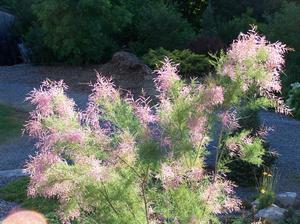Alien versus Predator
As reported in the May, 2010 issue of the Avant Gardener: “We seem to be at least beginning to go beyond the point of near-hysteria about invasive plants.” Growing choruses in many states implicate invasive bans as excessive. Why? Because too often well-meaning but botanically uneducated individuals have misidentified plants which were then summarily black listed. Those sightings were neither verified nor challenged by those who would know better.
For instance, a shrubby perennial known as Leadplant (Amorpha fruticosa) from the American Plains, had been banned in Connecticut though it is not invasive here. This has been stricken from the invasive list. A handful of tropical water plants lacking built-in genetic hardiness harbor no ability to survive our winters which had originally been listed have also now been removed.
The sale of wild beach rose, a European introduction, has not been outlawed in Connecticut. It has settled happily into the thread of land along the shoreline. Rosa rugosa tenaciously holds dunes together; its thorny branches keep people at bay barring anyone from trampling and degrading fragile dune ecosystems. Its flowers provide nectar to bees, butterflies and other beneficial insects. Late season rose hips provide forage in fall and winter to browsing mammals and birds. The benefits of wild Rosa rugosa if and when actually studied may outweigh any presumed threat to native dune grasses. Just because it has settled into the dune community doesn't automatically make it a thug. Indeed, the possibility exists that it actually enhances this habitat.
Eurasion tamarisk, or Salt Cedar is not invasive on the East Coast. But in high Ph and well-drained conditions tamarisk seeds about in portions of disturbed land in the southwestern U.S. Some ecologists have noted that "tamarisks are better suited than natives to colonize sites disturbed by human activities.” It is also now proven to be the preferred nesting site for an endangered species, the Southwestern Willow Flycatcher.
A non-native insect had been considered for introduction to control tamarisk. However, as reported in the Summit County Citizens Voice "the U.S. Department of Agriculture has terminated the use of a non-native insect used to destroy tamarisk after concluding that the bug was destroying critical habitat used by the southwestern willow flycatcher."
The relevance of a more reasoned and measured approach is timely. Due to a changing climate many of our Connecticut native plants have weakened which then have become increasingly susceptible to insect pests and disease organisms. Our native sugar maples and ashes are in decline. American elms have virtually disappeared from our woodlands within two generations. Our beautiful native flowering dogwood, Cornus florida, has virtually disappeared from Connecticut woodlands in our lifetimes.
Stronger, disease-resistant and more heat tolerant varieties of suffering populations of native plants must absolutely be identified or created in breeding programs. However, it may be folly to deny the potential benefits of near natives or even genetically related non-native counterparts to our languishing natives. If tougher natives cannot be found then new hybrids incorporating salient strengths using genetic material from both native and non-native parentage must be considered as alternatives.
An example is Chinese hemlock now being touted as a replacement for our native eastern hemlock. With 95% of our eastern hemlock estimated to have been destroyed by woolly adelgid entire ecosystems within the larger Eastern U.S forest mix have been decimated. Chinese hemlock is very similar in look and requirement to our native hemlock. The added bonus is that it harbors complete resistance to woolly adelgid. This potential replacement in the form of straight species or hybrid could buffer severely impacted native birds and insects, some entirely dependent upon this disappearing habitat.
In embracing a more tempered, open-minded and less puritanical approach to the invasive issue we may reach an understanding that not all alien species are the tsunami of a green nightmare as is kudzu vine farther south. There exist gradations, a handful possibly troubling but most proving innocuous. Newcomers in some instances may increase biodiversity by saving, modestly changing and even potentially enhancing an ecosystem without causing harm. Though controversial to some, this reflects the reasoned and balanced analytic approach as set forth by a growing number of ecological scientists whose voices had been previously drowned out.
Two factors must be applied when considering the invasive potency of a species:
1) Potentially invasive plants often require specific temperatures, soil types and light conditions in order to prosper. Bearing this in mind local research is imperative to make smart and informed decisions regarding new plant introductions.
2) Reduction of some of the worst invaders is likely impossible, both economically and practically until biological controls can be mounted. But we must seek controls for any truly problematic species.
May prevailing reason calm the hysteria.
penned by Wayne Paquette, December 2010
